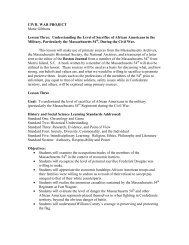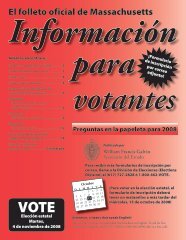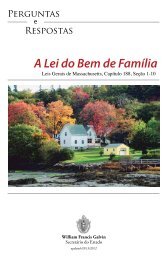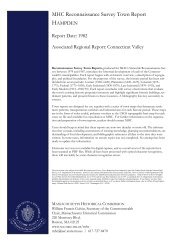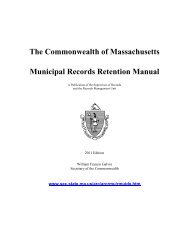Roads, Rails, and Trails - Secretary of the Commonwealth
Roads, Rails, and Trails - Secretary of the Commonwealth
Roads, Rails, and Trails - Secretary of the Commonwealth
You also want an ePaper? Increase the reach of your titles
YUMPU automatically turns print PDFs into web optimized ePapers that Google loves.
Accompanying all this lea<strong>the</strong>r were nearly 200 metal<br />
harness pieces such as buckles <strong>and</strong> rings. This is just what you<br />
would expect to find in a place where working horses were<br />
housed <strong>and</strong> outfitted. In <strong>the</strong> remains <strong>of</strong> a neighboring building,<br />
<strong>the</strong> archaeologists found evidence <strong>of</strong> a blacksmith shop,<br />
including horseshoes <strong>and</strong> o<strong>the</strong>r metal tack items. This may<br />
have been part <strong>of</strong> <strong>the</strong> company’s complex; if not, it is likely<br />
that <strong>the</strong> Metropolitan Railroad Company/West End Street<br />
Railway was one <strong>of</strong> this business’s most important customers.<br />
It seems entirely fitting that an archaeological research<br />
project done in advance <strong>of</strong> a modern urban mass-transit<br />
development should lead to greater knowledge about <strong>the</strong> birth<br />
37<br />
<strong>of</strong> urban mass transit. But <strong>the</strong> archaeologists’ research at <strong>the</strong><br />
Metropolitan Railroad Site ultimately went well beyond simply<br />
identifying <strong>the</strong> site <strong>and</strong> <strong>the</strong> activities that once went on <strong>the</strong>re.<br />
The finds from <strong>the</strong> excavations opened up new research<br />
opportunities. The collection <strong>of</strong> lea<strong>the</strong>r harness pieces shed<br />
light on nineteenth-century lea<strong>the</strong>rworking <strong>and</strong> “tack-nology,”<br />
<strong>and</strong> <strong>the</strong> paint chips collected from <strong>the</strong> site were analyzed to<br />
better underst<strong>and</strong> <strong>the</strong> paint chemistry <strong>of</strong> <strong>the</strong> period. In <strong>the</strong> end,<br />
<strong>the</strong> archaeologists gained a greater underst<strong>and</strong>ing <strong>of</strong> <strong>the</strong><br />
industrial growth <strong>of</strong> what is now Roxbury Crossing—how its<br />
various businesses grew, changed, moved, <strong>and</strong> competed with<br />
or depended on one ano<strong>the</strong>r.<br />
Blinders (left) <strong>and</strong> horseshoes (right) were essential equipment for horses working in urban areas.



